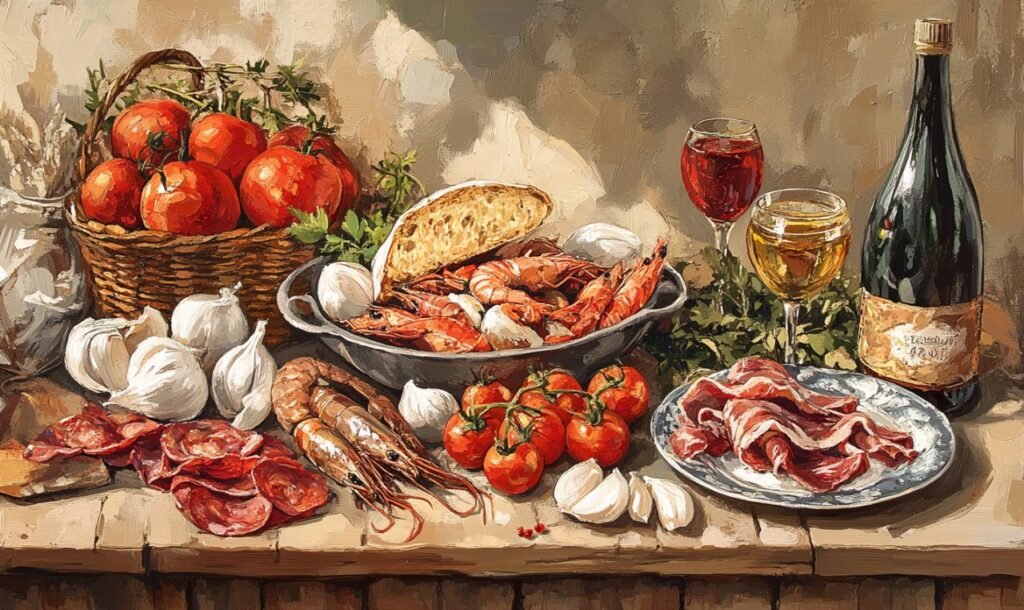In Spain, food is never just food. It’s tradition, a way of life, a story told over generations. That’s especially true with tapas—small, flavorful bites that suggest rather than overwhelm. A crispy croqueta, a slice of jamón, and shrimp glistening with garlic and oil are not just snacks. They’re an excuse to slow down, to talk, to share. In the end, tapas are Spain on a plate.

The Origins of Tapas: A Tale of Myths and Flies
The birth of tapas, like all good traditions, is shrouded in myth. One story credits King Alfonso X of Castile, who, while recovering from an illness, was advised to eat small bites with his wine. He loved the practice so much that he decreed all taverns must serve food with alcohol. Another theory points to Andalusian bartenders, who placed slices of ham or bread over sherry glasses to keep out flies—a habit that eventually evolved into something more refined.

The Ritual of Tapas: A Communal Affair
Eating in Spain is not solitary; it’s a communal experience, a dance of plates, hands, and overlapping conversations. Tapas are designed to be shared, passed from person to person in a culinary communion. To sit down to a plate of patatas bravas is to acknowledge that the meal is not just about sustenance—it’s about togetherness.
Nowhere is this clearer than in tapeo, the Spanish art of bar-hopping, one small plate at a time. In Seville, Granada, or San Sebastián, the evening unfolds as a slow-motion feast, each stop an opportunity to taste, talk, and revel in the moment.

A Regional Patchwork of Flavor
Like Spain itself, tapas culture is a mosaic. In the Basque Country, tapas take the form of pintxos, meticulously arranged on slices of bread, held together with a toothpick, often verging on the artistic. In Andalusia, tapas are heartier and humbler, echoing the region’s Moorish past. Meanwhile, in Catalonia, the Mediterranean asserts itself in dishes like pan con tomate, where simplicity is the ultimate sophistication
How to Make Classic Patatas Bravas at Home
If you’re ready to bring a taste of Spain to your kitchen, start with Patatas Bravas, one of the most iconic tapas dishes. Crispy potatoes smothered in a spicy tomato sauce—it’s simple, satisfying, and perfect for sharing.
Ingredients:
-
4 medium potatoes, peeled and cut into 1-inch cubes
-
3 tablespoons olive oil
-
Salt to taste
-
1 cup tomato sauce (canned or homemade)
-
1 teaspoon smoked paprika
-
1/2 teaspoon cayenne pepper (adjust to taste)
-
1 garlic clove, minced
-
1 tablespoon white wine vinegar
-
Mayonnaise or aioli for serving (optional)
Instructions:
-
Prep the Potatoes: Preheat your oven to 400°F (200°C). Toss the potato cubes with olive oil and salt, then spread them out on a baking sheet. Roast for 25-30 minutes, flipping halfway through, until golden and crispy.
-
Make the Sauce: In a small saucepan, combine the tomato sauce, smoked paprika, cayenne pepper, garlic, and vinegar. Simmer over low heat for 10 minutes, stirring occasionally.
-
Assemble: Place the crispy potatoes on a serving plate and drizzle generously with the spicy tomato sauce. Add a dollop of mayonnaise or aioli on the side if desired.
-
Serve: Enjoy immediately with friends, alongside a glass of Spanish wine or a cold beer.

A Final Toast to Tapas
In Spain, tapas are not just a way of eating; they are a way of being. They remind us that meals should be savoured, that conversation should be unhurried, and that life is best measured not in minutes but in bites.
So, in a Madrid bar, as the plates empty and the glasses clink, as strangers lean in to talk and the air hums with laughter, the lesson of tapas is clear: the best meals are never just about the food. They are about whom you share them with.
As the Spanish say, La vida es corta, pero ancha—life is short, but wide. And there’s no better way to fill it than with good food and good company.






